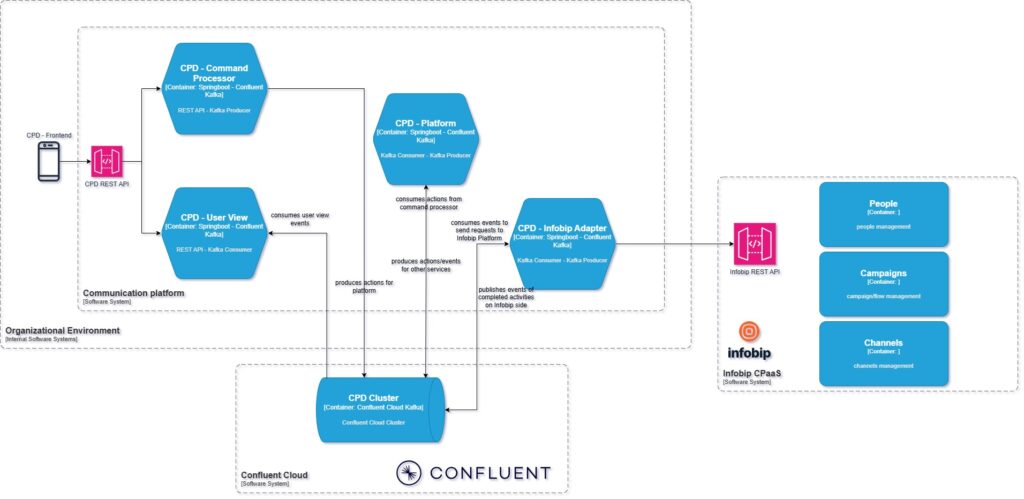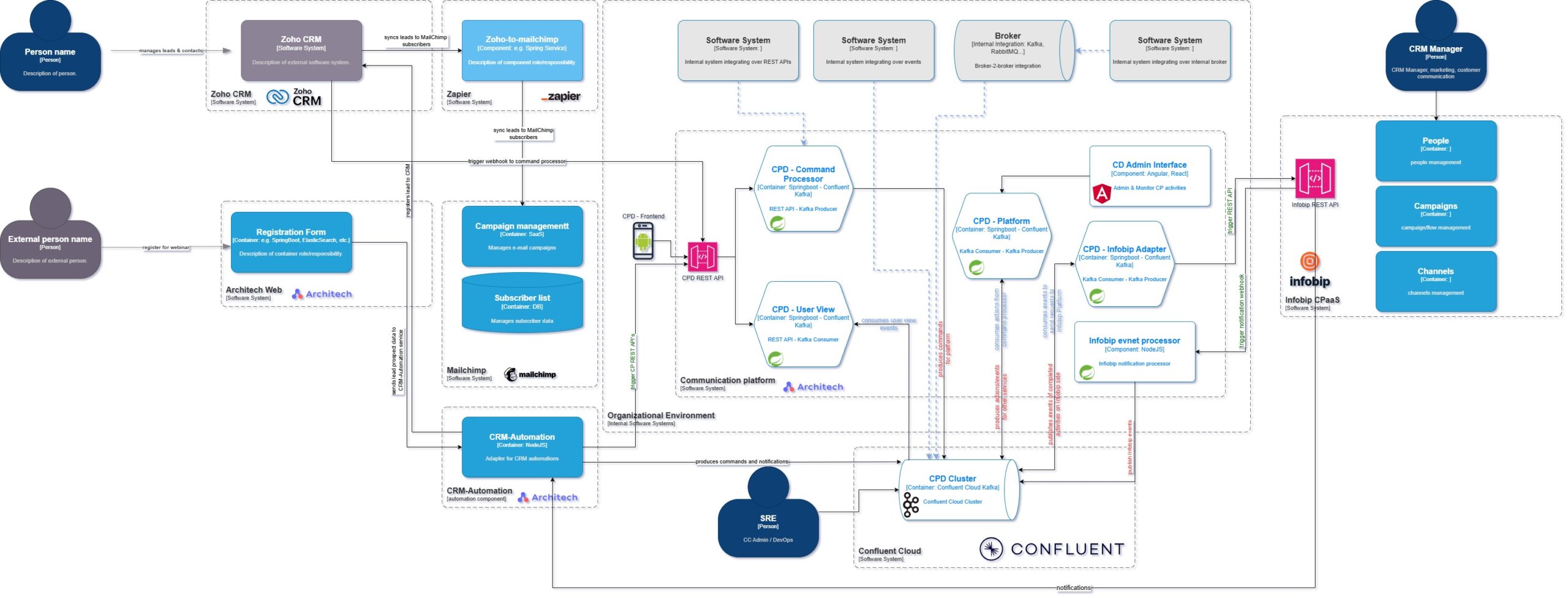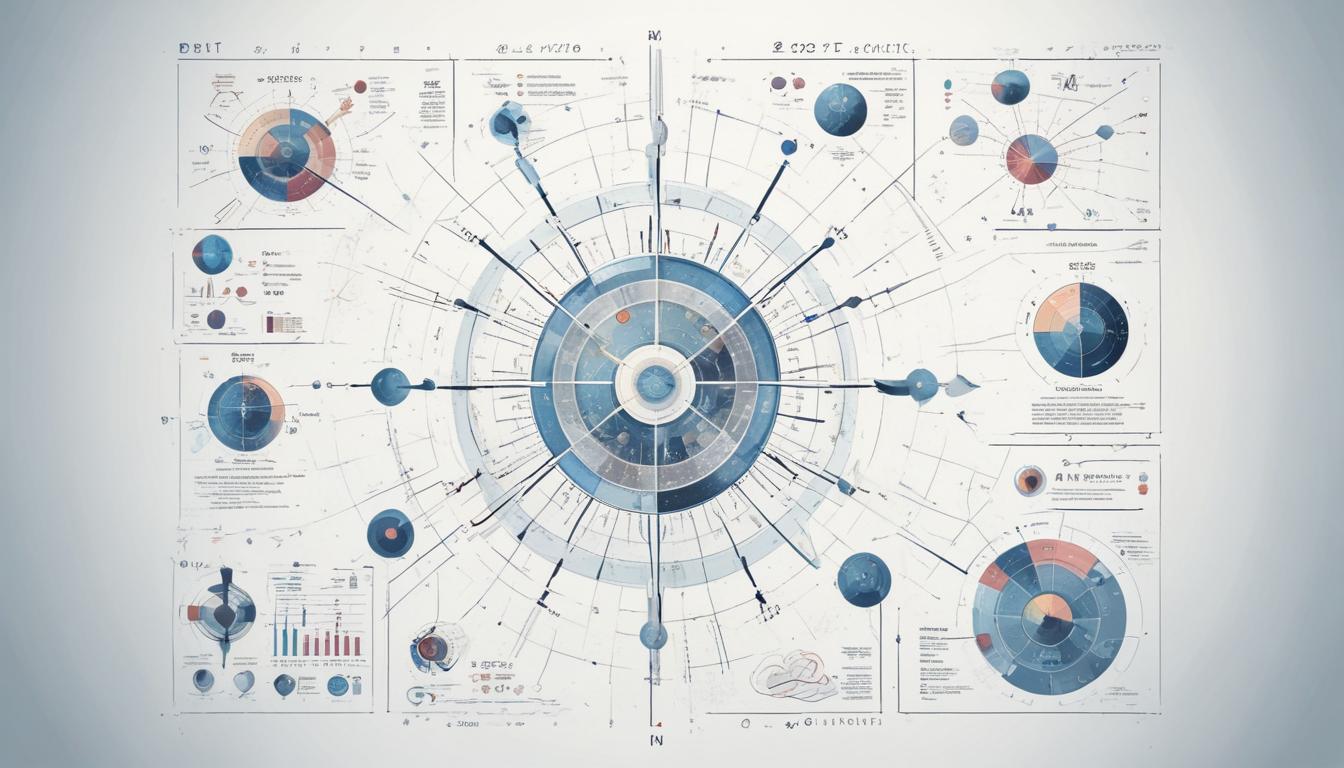In the fast-paced world of technology, the tension between innovation and technical debt is a constant challenge. As organizations strive to deliver new features rapidly, they often incur hidden costs that can stifle future growth. This report delves into the critical balance between these two forces, exploring real-world examples, root causes, and modern strategies for effective management. Discover how companies like Amazon and Nokia navigated this dilemma, and learn how the rise of Artificial Intelligence can both exacerbate and alleviate technical debt. Join us on this journey to understand the delicate art of balancing technical debt and innovation.
Continue readingEvent-driven architecture & real-time customer engagement
Revolutionizing Customer Engagement with Event-Driven Architecture
In a rapidly evolving digital landscape, customer engagement has become more critical than ever. Real-time interaction can make the difference between a satisfied customer and a lost opportunity.
This blog post will demonstrate how Event-Driven Architecture (EDA) can be leveraged to build a responsive communication platform that facilitates real-time customer engagement, as presented in our recent webinar hosted in collaboration with Confluent Inc. and Infobip.
Understanding Event-Driven Architecture
Event-Driven Architecture is a software design pattern in which decoupled applications can asynchronously publish and subscribe to events. This design allows systems to react to events in real-time, facilitating responsive and scalable solutions.
Key Characteristics of EDA
Asynchronous Communication: Components communicate through events without waiting for a response, enhancing system responsiveness.
Decoupling: Producers and consumers of events are independent, allowing for flexible scaling and maintenance.
Scalability: EDA can handle high volumes of events and data, making it suitable for large-scale applications.
EDA is a fundamental paradigm in software design that focuses on producing, detecting, consuming, and reacting to events. An event can be defined as a significant change in state, such as a user clicking a button, a sensor sending a temperature reading, or a financial transaction being completed. EDA’s core advantage is its asynchronous communication model, where components, or services, do not communicate directly but rather through events that are published to an event broker or bus.
This decoupling allows services to be independently developed, deployed, and scaled, significantly enhancing the flexibility and resilience of the system. Each event is essentially a message that contains information about a state change, which other components in the system can consume and react to appropriately. This pattern is particularly useful in scenarios requiring real-time processing and responsiveness, such as online financial transactions, real-time analytics, IoT applications, and complex event processing in distributed systems.
Components
In EDA, the architecture typically involves three main components: event producers, event consumers, and event brokers. Event producers are responsible for detecting changes in the state and publishing these events to the event broker. Event consumers subscribe to specific types of events and execute certain actions when those events are detected. The event broker acts as the intermediary that ensures reliable delivery of events from producers to consumers. This broker is often implemented using message-oriented middleware technologies like Apache Kafka, RabbitMQ, or Amazon Kinesis.
One of the key benefits of this setup is the inherent scalability and fault tolerance it provides. Since producers and consumers are decoupled, each can scale independently based on demand. Furthermore, the event broker can replicate events across multiple nodes, ensuring high availability and resilience against failures.
This architecture also supports eventual consistency, where systems are designed to be consistent in the long run, even if intermediate states might temporarily diverge. EDA’s inherent characteristics make it an ideal choice for building responsive, scalable, and maintainable systems in modern software engineering.
Commands and command processors
In the context of EDA, commands and command processors play crucial roles in the system’s operation and workflow management.
Commands are explicit requests to perform a specific action or change a state, typically initiated by a user or an external system. These commands encapsulate all the necessary information required to execute an action, ensuring that the intent and context are clear and unambiguous.
Command processors, on the other hand, are dedicated components responsible for handling these commands. When a command is issued, the command processor validates it, executes the necessary business logic, and then publishes events to the event bus or broker to notify other components about the change in state. This separation of concerns allows for greater modularity and scalability, as command processors can be independently developed, tested, and deployed.
By processing commands asynchronously and generating events, command processors facilitate a responsive and decoupled system architecture, enabling efficient handling of complex workflows and ensuring that different parts of the system remain loosely coupled yet highly cohesive.
Webinar
In our recent webinar, we delved into the intricacies of using Event-Driven Architecture (EDA) to enhance real-time customer engagement. A pivotal aspect of this architecture is the use of commands and command processors, which are essential for handling specific user requests and actions within the system. Commands, such as user registration or purchase initiation, encapsulate all necessary information for executing a particular task. These commands are processed by command processors, which validate and execute the necessary business logic. For instance, when a user signs up on our platform, the command processor handles the registration process, publishes relevant events to the event bus, and triggers subsequent workflows like sending a welcome email or updating the user engagement metrics.
The architecture we presented, in collaboration with Confluent Inc. and Infobip, exemplifies the power of EDA in creating a robust real-time communication platform. Our solution integrates seamlessly with various components, from the CPD Command Processor to the Infobip Adapter, ensuring that every event, from user actions to system notifications, is handled asynchronously and efficiently. This decoupling allows for independent scaling and maintenance of each component, ensuring the platform can handle high volumes of events and data without bottlenecks.
For example, during a marketing campaign, the command processors can manage numerous user interactions in real-time, triggering personalized messages through Infobip’s platform and ensuring immediate and relevant customer engagement. This architecture not only enhances the user experience by providing timely responses but also allows businesses to scale their operations seamlessly, adapting to growing demands and ensuring continuous engagement with their customers.
Core Components of the EDA Solution
The CPD Platform, as illustrated in the architecture diagrams, comprises several core components designed to facilitate real-time customer engagement through Event-Driven Architecture (EDA).
Confluent
Central to this architecture is the CPD Cluster, which operates on Confluent Cloud, ensuring scalability and fault tolerance. This cluster serves as the backbone for the platform’s event processing capabilities, managing the flow of events between various components and ensuring reliable message delivery.
Confluent Cloud, built on Apache Kafka, provides a fully managed platform that supports real-time data streaming and event processing at scale. Its architecture ensures high availability and fault tolerance, making it ideal for handling the large volumes of data generated by modern applications. Confluent Cloud offers several key benefits that enhance the capabilities of an EDA system:
- Elastic Scalability: The platform can scale resources dynamically to meet varying demand, ensuring consistent performance during peak usage periods.
- Data Durability and Reliability: With features like data replication and automatic failover, Confluent Cloud ensures that event data is preserved and accessible, even in the event of infrastructure failures.
- Low Latency: Confluent Cloud’s architecture is optimised for low-latency data streaming, which is crucial for real-time applications that require immediate processing and response.
CPD – Communication Platform Demo
The CPD Platform component itself acts as the orchestrator, consuming actions from the Command Processor and generating events for other services. This modular setup allows for easy extension by adding new event types or integrating additional services without disrupting the existing infrastructure.
If needed, you can increase modularity by developing “CPD Platform” components for specific use case, or set of common use cases. This would go towards orchestrator pattern where you have one service ( one process ) which orchestrates services, commands and events around one use case.
For instance, integrating a new customer feedback system would involve producing and consuming specific events related to feedback collection and analysis, seamlessly incorporating it into the platform’s workflow.
The CPD User View and CPD Infobip Adapter are pivotal components in delivering a responsive user experience. The User View component consumes events related to user interactions, ensuring the system’s state is updated in real-time and accurately reflects user activity. This is crucial for maintaining an up-to-date user interface and providing immediate feedback to users.
Extending the User View involves subscribing to new event types or enhancing processing logic to handle additional data, ensuring the platform remains adaptable to evolving business needs.
Infobip
Infobip Adapter, on the other hand, interfaces with the Infobip CPaaS, consuming events to send requests and publishing events upon completion of activities. This integration enables the platform to leverage Infobip’s robust communication capabilities for tasks such as sending notifications or processing user responses. Extending the Infobip Adapter can involve incorporating new communication channels or enhancing existing ones, ensuring that the platform can scale and adapt to provide comprehensive real-time customer engagement solutions.
Infobip’s Communication Platform as a Service (CPaaS) integrates various communication channels, enabling businesses to engage with customers through SMS, email, voice, and other messaging platforms. This integration allows for a unified communication strategy that can be tailored to the preferences and behaviours of individual customers. Key aspects of Infobip CPaaS include:
- Omnichannel Engagement: Infobip CPaaS supports a wide range of communication channels, ensuring that businesses can reach their customers on their preferred platforms.
- Scalability: The platform can handle high volumes of interactions, making it suitable for businesses with large customer bases or those experiencing rapid growth.
- Analytics and Insights: Infobip provides tools for monitoring and analysing communication effectiveness, allowing businesses to optimise their engagement strategies based on real-time data.
Integration within a Comprehensive Environment
The broader architecture diagram illustrates how our core solution integrates within a larger ecosystem, interfacing with various internal and external systems.
In real-life, we have more complex environments and systems integrated in one use case. To enable and facilitate this kind of complexities, we use EDA as “glue” that connects all required components.
Real-World Applications and Benefits
The practical applications of this architecture are vast, particularly in scenarios requiring real-time customer engagement. For example, in financial services, such an architecture can provide immediate fraud detection and personalised financial advice based on real-time data analysis. In e-commerce, it can enhance customer experiences through real-time recommendations and notifications, increasing engagement and conversion rates.
Benefits of EDA in Customer Engagement
- Immediate Response to User Actions: By processing events as they occur, the system can provide immediate feedback and interactions, essential for enhancing user satisfaction.
- Scalable and Resilient: The platform can scale to accommodate growing user bases and data loads, ensuring consistent performance. Kafka’s built-in features for data replication and fault tolerance further enhance system reliability.
- Integration with Multiple Channels: The ability to integrate seamlessly with various communication channels through platforms like Infobip CPaaS allows businesses to engage customers on their preferred platforms, creating a cohesive and unified customer experience.
Conclusion
Event-Driven Architecture, as exemplified by the CPD platform, offers a robust framework for building scalable, real-time communication systems. By leveraging the strengths of Confluent Cloud and Infobip, businesses can create highly responsive systems that not only meet the demands of modern customer engagement but also provide a flexible foundation for future growth and innovation. This architectural approach not only addresses current business needs but also positions organisations to adapt to the rapidly changing digital landscape, ensuring long-term success and customer satisfaction.
Architecture Observability
-
Nenad Crnčec
- June 6, 2024
- 12:31 pm
- No Comments
- 5 minutes
Enhancing Software Architecture with vFunction: Insights from Amir Rapson
I recently had the pleasure of moderating an incredible tech-talk session with Amir Rapson, CTO and Founder of vFunction. Tech-session was organised TBC Bank from Georgia. We delved deep into the nitty-gritty of architectural observability and its role in tackling technical debt. If you couldn’t join us, here are the highlights and key takeaways from our discussion.
Understanding Architectural Observability and Technical Debt
Amir kicked off the session by emphasising the importance of architectural observability. It’s not just about keeping an eye on our code; it’s about truly understanding the architecture of our systems. This awareness helps us pinpoint and address technical debt early, keeping our software scalable and resilient.
One of the biggest eye-openers for me was how Amir linked technical debt directly to business outcomes. It’s easy to think of it as just a developer’s problem, but in reality, unchecked technical debt can slow down our engineering velocity and lead to more frequent outages, impacting the bottom line.
Refactoring: Beyond Service Extraction
We talked about the common challenge of extracting services from monolithic applications. Amir made it clear that it’s not enough to just pull out services. To do it right, you need to refactor the monolith to improve its internal structure, ensuring that the new services don’t end up with messy dependencies.
This approach to refactoring is crucial for achieving a modular architecture. It’s all about breaking down the monolith in a way that each piece can operate independently without creating a tangled web of dependencies.
Tools and Techniques for Better Architecture
Amir shared some fantastic insights on using tools like vFunction in conjunction with SonarQube. The integration of these tools can significantly enhance our ability to manage code quality and architectural dependencies. He explained the importance of combining dynamic and static analysis to get a full picture of our software architecture.
Dynamic analysis helps us understand the real-time interactions and method calls in our applications, while static analysis gives us a snapshot of dependencies and code structure. Using both, we can gain comprehensive insights and make informed decisions about refactoring and improvements.
Boosting Engineering Velocity and Business Confidence
One of the big topics we covered was how technical debt affects engineering velocity. Amir pointed out that exhaustive testing and regression testing due to technical debt can really slow us down. This resonated with me because it’s something many teams struggle with. He shared strategies to balance thorough testing with maintaining high velocity, such as reducing regression testing and improving deployment frequency.
We also discussed regaining business confidence after tackling technical debt. It’s not just about fixing the code; it’s about demonstrating improved reliability and reduced risk to the business. Amir emphasized the importance of showing tangible metrics to the business to rebuild trust and move towards quicker, independent deploys.
Good vs. Bad Architecture
We all know bad architecture when we see it—a complete mesh of services with no clear structure. Amir highlighted the characteristics of good architecture, like having minimal interdependencies and clear separation of concerns. He warned against the pitfalls of creating a service mesh, which can lead to a complex and hard-to-maintain system.
Instead, Amir advocated for layered architectures that maintain modularity and reduce complexity. This way, each layer has a specific role, and dependencies are clear and manageable.
Optimizing Database Interactions
We also touched on database usage and how vFunction can help optimize it. Amir explained how the tool provides insights into whether we should use relational or non-relational databases and when to implement caching strategies. These insights are invaluable for improving database performance and overall application efficiency.
Practical Implementation and Continuous Improvement
Integrating vFunction into the software development lifecycle was another key point. Amir stressed that vFunction should be used continuously to manage technical debt and maintain good architecture. He shared metrics that teams can track, like delivery times, recovery times, and the number of incidents, to measure the success of their efforts.
Final Thoughts
This tech-talk with Amir was a deep dive into the heart of software architecture. It reinforced the idea that managing technical debt and maintaining good architecture are ongoing processes that require continuous effort and the right tools. By integrating solutions like vFunction, we can achieve better business outcomes, improve engineering efficiency, and build scalable and resilient software systems.
Addressing technical debt isn’t just about cleaning up code; it’s about ensuring long-term success and fostering innovation. I’m excited to see how these insights and strategies will help us all navigate the complexities of modern software development.
Thanks for reading, and here’s to building better software together!





